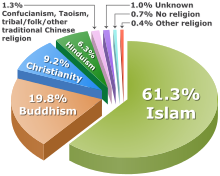Malaysians
Parts of this article (those related to the statistics for Population and Culture section) need to be updated. (August 2020) |
Orang Malaysia ( | |
|---|---|
| Religion | |
| Predominantly Minority
| |
| Related ethnic groups | |
| Filipinos Indonesians |
Malaysians are citizens who are identified with the country of Malaysia. Although citizens make up the majority of Malaysians, non-citizen residents and overseas Malaysians may also claim a Malaysian identity.[10]
The country is home to people of various
Population
As of 2010, Malaysians make up 0.4% of the world's total population, having relied upon immigration for population growth and social development. Approximately 30% of current Malaysians are first- or second-generation immigrants, and 20 percent of Malaysian residents in the 2000s were not born in Malaysian soil.[citation needed] It is estimated, by 2031, nearly one-half of Malaysians above the age of 15 will be foreign born or have one foreign born parent. Bumiputera, according to the 2010 Malaysian Census, numbered at 17,523,508 or 61.85% of the country's 28,334,135 population.
Citizenship and diaspora
The Malaysian diaspora has a population of 1,730,152 in 2019, according to the United Nations Department of Economic and Social Affairs.[1] Malaysia does not keep track of emigration and counts of Malaysians abroad are thus only available courtesy of statistics kept by the destination countries. The diaspora includes both descendants of early emigrants from Malaysia, as well as more recent emigrants from Malaysia.
Since independence, a total of 688,766 naturalised foreigners had been granted Malaysian citizenship while 10,828 individuals had their citizenships revoked.[12][13] The community of Malaysians in Australian external territory of Christmas Island makes up the majority of the population, while Singapore has the largest minority community of Malaysians, with 952,261 people, followed by Australia, the United Kingdom and the United States.
Ethnic groups and citizenship
Classification of
| Peninsular Malaysia | Sabah and Federal Territory of Labuan |
Sarawak |
|---|---|---|
| Malaysian Citizens | ||
| Bumiputera |
Bumiputera Malay Bajau Murut |
Bumiputera |
|
Other Bumiputera
| ||
|
Non-Bumiputera Chinese
Indian
Others
| ||
| Non-Malaysian Citizens (including Permanent Residents) | ||
| ||
Information collected in the census including ethnic group and citizenship was based on respondent's answer and did not refer to any official document.
Information on citizenship should be used with caution as it is subject to content and coverage errors especially for non-citizens as in censuses in most countries.
Culture
Language
Malaysia contains speakers of 137 living languages,
Religion

The Malaysian constitution guarantees freedom of religion while making Islam the state religion.[16] According to the Population and Housing Census 2010 figures, ethnicity and religious beliefs correlate highly. Approximately 61.3% of the population practice Islam, 19.8% practice Buddhism, 9.2% Christianity, 6.3% Hinduism and 1.3% practice Confucianism, Taoism and other traditional Chinese religions. 0.7% declared no religion and the remaining 1.4% practised other religions or did not provide any information.
References
- ^ a b c d e f g h i j k l m n o p "International migrant stock 2019". United Nations. 2019. International migrant stock – By destination and origin. Retrieved 25 June 2020. Figures includes Malaysians in UN member nations
- direct link to .xlsx file: [1]
- In Table 1 under Column EE "Malaysia", Rows are the destinations.
- ^ "Malaysia Population Clock". Department of Statistics, Malaysia. Archived from the original on 5 December 2013. Retrieved 16 March 2014.
- ISBN 9781604975109.
- ^ "Total ancestry categories tallied for people with one or more ancestry categories reported 2010 American Community Survey 1-Year Estimates". United States Census Bureau. Archived from the original on 18 January 2015. Retrieved 30 November 2012.
- ^ "Leveraging on Malaysian diaspora". The Star. 16 March 2012. Archived from the original on 6 October 2015. Retrieved 23 April 2015.
- ^ Soong Siew Hoong (29 March 2012). "Some Statistics on Malaysian Working in Overseas Countries in OIC; Commonwealth; BRICS; PIIGS; UN" (PDF). Chinese Chamber of Commerce and Industry of Kuala Lumpur and Selangor. Archived from the original (PDF) on 19 October 2017. Retrieved 23 April 2015.
- ^ Sara Cluster (21 August 2012). "Malaysia PM: study hard abroad and return home". The Pie News. Retrieved 23 April 2015.
- Ministry of Foreign Affairs of Japan. 7 July 2018. Archivedfrom the original on 7 May 2022. Retrieved 29 May 2022.
- ^ "Imigrantes internacionais registrados no Brasil". www.nepo.unicamp.br. Retrieved 20 August 2021.
- ^ Neville Spykerman; Michelle Tam; Victoria Brown (3 May 2015). "Survey: Most prefer to be known as Malaysian". The Star. Retrieved 3 May 2015.
- ^ "Malaysia - Ethnic Groups, Languages, Religions | Britannica". www.britannica.com.
- ^ Laili (29 March 2016). "688,766 foreigners granted citizenship since Independence - Home Ministry". New Straits Times. Retrieved 29 June 2016.
- ^ Martin Carvalho (29 March 2016). "Zahid: Close to 700,000 granted citizenship since Merdeka". The Star. Retrieved 29 June 2016.
- ^ "Ethnologue report for Malaysia". Ethnologue.com. Retrieved 18 October 2010.
- ^ "Ethnologue report for Malaysia (Peninsular)". Ethnologue.com. Archived from the original on 10 May 2011. Retrieved 18 October 2010.
- ^ "Malaysia – Religion". Asian Studies Center – Michigan State University. Archived from the original on 9 August 2011. Retrieved 13 July 2011.
Further reading
- Saw Swee-Hock (6 January 2015), The Population of Malaysia (Second Edition), Institute of Southeast Asian Studies, pp. 220–, ISBN 978-981-4620-36-9
